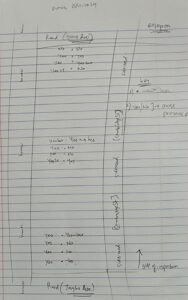I have planned to study the Green Ash ornamental trees along a small section of around 400 meters on Cambridge Street. The street has a total of 29 trees when counted on the pedestrian side, which is also the site of research. While I was having a closer examination of these trees, I noticed varying degrees of moss presence on the bark of these trees. The time I was out in my field of research was 6:10 PM on March 13th, 2024 and the temperature was around -1 Celsius
Three locations were selected along the entire street for further examination. The locations were selected so that two were closer to the other streets, Grant Ave and Taylor Ave, respectively, and one of the locations was right in the middle of the two streets. I started inspecting/walking from the side of Taylor Ave on Cambridge Street to Grant Avenue. The trees were more clustered together in the middle of the street, while the ones closer to Taylor and Grant Ave had more distance between each tree.
While walking, I inspected some of the trees on the Taylor Avenue side. The side of the tree bark facing the area where houses/buildings were located somehow had more moss coverage on the bark of the tree. The same was seen on the trees that were closer to Grant Ave, with the side of the bark that was more covered. I noticed a pattern that the bark side facing the houses had mostly moss in the trees, and the side of the bark facing the open road (Cambridge St) somehow had less frequency of moss presence. I also noticed one tree in the middle of the street which had bark lice sticking to a tape and this tree did not have any visible moss presence.
The hypothesis which I would generate based on my observation is: The bark of Ash trees facing the side with houses (sheltered side) exhibits higher levels of moss growth compared to the bark facing the road (the more open side).
Prediction: If the presence of houses influences moss growth, then trees located closer to houses will exhibit greater moss coverage on the side facing the houses compared to the side facing the road.
Response variable: Moss coverage on the bark of ash tree (Type: Continuous).
Explanatory variable: Orientation of the tree relative to nearby houses or road (Type: Categorical).

Sorry it took me a while to comment, I got a bit behind on blogs. This all looks good. What direction are the trees facing the house? Are they shaded from the houses or get less sun because of the direction they face?